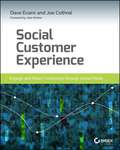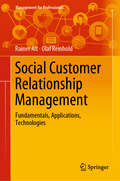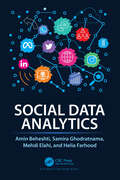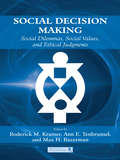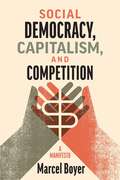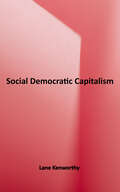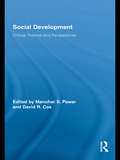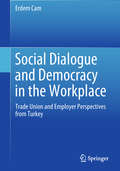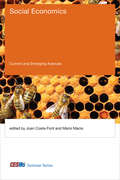- Table View
- List View
Social Currency: Paying Attention to What Everyone is Paying Attention to
by Rebekah BuegeMost people waste years of their life, not because they don’t know their purpose, but because their attention is broken, scattered, and sold to the highest bidder without their knowledge.Imagine a day where you’re mentally present, fully focused, and at peace. Even though you’re more productive than usual, you don’t feel rushed or impatient with yourself. You’re protected from distractions, notifications, and thoughts that used to steal your attention away from the moment. Your day feels full, but manageable, because you enjoy most of what’s on your calendar. Days like this are only possible when you start paying attention.Social Currency is an examination of the value of one’s attention, how to protect and invest that attention, practical ways to create a joyful life, and why this matters now more than ever.
Social Customer Experience
by Dave Evans Joe CothrelSocial Customer Experience: Engage and Retain Customers through Social Media builds on the prior works of author Dave Evans. As an update to Evans's earlier book Social Media Marketing, the new Social Customer Experience connects the early cases presented in 2010 with significant, contemporary examples, key concepts, and best practices associated with the adoption of social technology by global brands. This latest edition offers a blueprint for transforming your organization's disparate social initiatives into a unified social experience strategy. Most people know that social technologies are transforming business, but few understand how those changes are happening across the organization. Whether in marketing, communications, customer care, digital media or product development these changes shape the way in which business manage the experience their customers have with the brand. Filled with practical examples of what to do, and illustrated with cases taken from real companies, Social Customer Experience fills in the gaps for companies who want to do more with social than just listen and experiment.Part I lays the groundwork by explaining the three waves of change that combine to form social customer experience: social technologies and their impact on Web 1.0 digital infrastructures; social customers and their impact on marketing and support operations; and the new discipline of customer experience management that is reframing the old sales-and-service-centric ways of thinking about how companies relate to customers. Part I concludes by defining the social customer experience ecosystem, both on and off your own web domain.Part II, "Your Social Presence," puts you on the ground, with tactics and examples for how to apply social technologies and achieve your business objectives, how to measure and analyze social data and show business value, and how to implement a best-practice approach to avoid common traps and pursue proven opportunities.Part III digs deeper into the five building blocks of social customer experience: organization, platform, content, people and tools. What's a social experience organization look like? What systems need to be in place? How do you get the most out of the social "objects" - content and other assets - that are the byproduct of great social customer experiences? How do connections between customers - the social graph - come into play? And what applications will you use - literally, what will you empower your customers to do? Part III answers these questions in the practical, method-driven style of authors Dave Evans and Joe Cothrel. Social Customer Experience features detailed exercises that show you how to translate learning into action, hands-on tutorials using today's social media tools and platforms, and compelling, modern case studies from organizations of all sizes--from the Fortune 500 to nonprofits and mom-n-pop main-street shops. As a bonus, the book also features resources and references to connect readers with the current thought leaders and sources of timely information.If you're interested in business, and how business is being reshaped by social technology, Social Customer Experience will show you a path to a new relationship with your customers, customers not only buy your products and services but get more out of them and go on to become partners in your business-selling, supporting, and innovating on your behalf.
Social Customer Relationship Management: Fundamentals, Applications, Technologies (Management for Professionals)
by Rainer Alt Olaf ReinholdSocial media has received considerable attention, and many potential benefits, as well as concerns, are now being discussed. This book explores how social media can successfully support business processes in marketing, sales and service in the context of customer relationship management (CRM). It presents the fundamentals of Social CRM and shows how small and large companies alike have implemented it.In turn, the book presents analytic and operational software tools that offer features for enhancing and streamlining interactions with customers. The book concludes with an overview of essential design areas that businesses need to bear in mind when introducing social media into their CRM strategies. In this regard, it also points out key success factors, limitations, and data protection aspects.
Social Customer Relationship Management: Grundlagen, Anwendungen und Technologien
by Rainer Alt Olaf ReinholdDieses Buch zeigt wie die Verbindung von Social Media mit Customer Relationship Management (CRM) Perspektiven für Marketing, Verkauf und Service schafft. Es kombiniert dazu Grundlagenwissen und Fallbeispiele. Für das Social CRM identifizieren die Autoren vier Verwendungszwecke sowie drei Umsetzungsstufen und thematisieren auch Fragen der Datenerschließung und der Datenqualität. Es richtet sich sowohl an Praktiker als auch an Lehrende und Studierende.
Social Data Analytics
by Amin Beheshti Samira Ghodratnama Mehdi Elahi Helia FarhoodThis book is an introduction to social data analytics along with its challenges and opportunities in the age of Big Data and Artificial Intelligence. It focuses primarily on concepts, techniques and methods for organizing, curating, processing, analyzing, and visualizing big social data: from text to image and video analytics. It provides novel techniques in storytelling with social data to facilitate the knowledge and fact discovery. The book covers a large body of knowledge that will help practitioners and researchers in understanding the underlying concepts, problems, methods, tools and techniques involved in modern social data analytics. It also provides real-world applications of social data analytics, including: Sales and Marketing, Influence Maximization, Situational Awareness, customer success and Segmentation, and performance analysis of the industry. It provides a deep knowledge in social data analytics by comprehensively classifying the current state of research, by describing in-depth techniques and methods, and by highlighting future research directions. Lecturers will find a wealth of material to choose from for a variety of courses, ranging from undergraduate courses in data science to graduate courses in data analytics.
Social Decision Making: Social Dilemmas, Social Values, and Ethical Judgments (Organization and Management Series)
by Max H. Bazerman Ann E. Tenbrunsel Roderick M. KramerThis book, in honor of David Messick, is about social decisions and the role cooperation plays in social life. Noted contributors who worked with Dave over the years will discuss their work in social judgment, decision making and ethics which was so important to Dave. The book offers a unique and valuable contribution to the fields of social psychology and organizational behavior. Ethical decision making, a central focus of this volume, is highly relevant to current scholarship and research in both disciplines. The volume will be suitable for graduate level courses in organizational behavior, social psychology, business ethics, and sociology.
Social Decision Systems Science: Theory and Applications in Southeast Asia (Translational Systems Sciences #42)
by Utomo Sarjono Putro Santi Novani Kyoichi Kijima Pri HermawanThis book applies a decision systems science perspective to social systems, using the case of Southeast Asia to illustrate the concepts it sets forth. Southeast Asia is one of the most culturally diverse parts of the world, comprising 11 countries with a combined population of approximately 647 million people. The focus is on Indonesia, the largest and most populous country in the region. Indonesia is an archipelago that is highly heterogeneous. It is the world’s fourth most populous country, with some 280 million people spread over 17,508 islands. Great diversity is seen in its culture; however, most of the people greatly value collectiveness or exhibit high sociability and solidarity, i.e., a communal culture. In the culture of business in Indonesia, relationships are absolutely essential as a basis of decision making, thus it is quite different than that found in the West. The ensuing daily complexities require intensive interaction, negotiation processes, and coordination. In this context, common theories and best practices that are generated on the basis of more simplified assumptions often fail. Systems science offers an approach that can take these issues into account and potentially overcome such complexities. This book defines a social system as a complex interconnected set of entities that organize the life of human beings and that are implemented through a process of shared experience and creative tension such that they demonstrate emergent characteristics. To elucidate this definition, the discussion in the book aims to bridge and integrate basic research founded in systems concepts, logic, theories, and models of systems practices and methodologies into a process of social systems research. That process involves engaging various stakeholders in academia, business, and government so that in collaboration they can solve common problems based on multidisciplinary approaches—ones that encompass hard and soft and quantitative and qualitative systems as well as negotiations and simulations. The book has three major parts, the first of which discusses the importance of decisions in social system science that can be applied in managing complexities. The second part describes the use of multidisciplinary approaches for social systems, and the third deals with efforts to apply previously accepted concepts to real cases in Indonesia.
Social Democracy in Capitalist Society (Routledge Revivals): Working-Class Politics in Britain and Sweden
by Richard ScaseFirst published in 1977. This book considers the nature of industrial society, contemporary capitalism and the impact of political ideas on social structure. These ideas are discussed by reference to the impact of social democracy on the structure of capitalist society in a comparative analysis of Britain and Sweden — including an interview survey of industrial workers socio-political attitudes. The study is concluded by a general discussion of the role of social democracy in capitalist society. It is argued that the development of social democracy generates ‘strains’ which, in the long term, question the legitimacy of capitalism among industrial manual workers.
Social Democracy, Capitalism, and Competition: A Manifesto
by Marcel BoyerOur social democracies and welfare states face economic and governance challenges that threaten their very survival. Against this backdrop, Social Democracy, Capitalism, and Competition argues that a true social democracy requires a clear definition and a refocusing of the roles of the public and private sectors.Using his novel competition-based social democracy and new competition-based capitalism models, Marcel Boyer goes back to the basics. Returning to the foundational characteristics of what social democracy and capitalism are supposed to be, he reimagines how public and social goods and services – such as education, healthcare, and transport infrastructure – can be provided in a way that aligns with citizens’ best interests. Boyer shows how recent decades have witnessed a shift away from competition and competitive processes, toward more bureaucratic control of public and social goods and services and more ironclad protection of state providers against contestation by potentially competitive organizations. This crony capitalism results in loss of purpose, organizational inefficiency, and outcomes that increasingly deviate from their original objectives of social wellbeing. Boyer maintains that productivity gains, economic growth, and prosperity for all actually require a degree of income and wealth inequality.Written with a facility that will appeal to anyone interested in public policy and economic reform, Social Democracy, Capitalism, and Competition is a book all governments should have on their reading list.
Social Democratic Capitalism
by Lane KenworthyWhat configuration of institutions and policies is most conducive to human flourishing? The historical and comparative evidence suggests that the answer is social democratic capitalism - a democratic political system, a capitalist economy, good elementary and secondary schooling, a big welfare state, pro-employment public services, and moderate regulation of product and labor markets. In Social Democratic Capitalism, Lane Kenworthy shows that this system improves living standards for the least well-off, enhances economic security, and boosts equality of opportunity. And it does so without sacrificing other things we want in a good society, from liberty to economic growth to health and happiness. Its chief practitioners have been the Nordic nations. The Nordics have gone farther than other rich democratic countries in coupling a big welfare state with public services that promote high employment and modest product and labor-market regulations. Many believe this system isn’t transferable beyond Scandinavia, but Kenworthy shows that social democratic capitalism and its successes can be replicated in other affluent nations, including the United States. Today, the U.S. lags behind other countries in economic security, opportunity, and shared prosperity. If the U.S. were to expand its existing social programs and add some additional ones, many ordinary Americans would have better lives. Kenworthy argues that, despite formidable political obstacles, the U.S. is likely to move toward social democratic capitalism in the coming decades. As a country gets richer, he explains, it becomes more willing to spend more in order to safeguard against risk and enhance fairness. With social democratic capitalism as his blueprint, he lays out a detailed policy agenda that could alleviate many of America's problems.
Social Design: Essays in Memory of Leonid Hurwicz (Studies in Economic Design)
by Walter TrockelThis book contains invited essays in memory of Leonid Hurwicz spanning a large area of economic, social and other sciences where the implementation or enforcement of institutions and rules requires the design of effective mechanisms. The foundations of these articles are set by social choice concepts; game theory; Nash, Bayesian and Walrasian equilibria; complete and incomplete information. Besides in-depth treatments of well-established parts of mechanism and implementation theory, contributions on novel directions deal, for instance, with a quantum approach to game and decision making under uncertainty; digitalization; and the design of block chain for trading. The outstanding competence and reputation of the authors reflect the appreciation of the fundamental contributions and the lasting admiration of the personality and the work of Leonid Hurwicz.
Social Determinants of Health at Boston Medical Center
by Susanna Gallani Kathryn Reddy Kaya BosCase
Social Determinants of Health in Non-communicable Diseases: Case Studies from Japan (Springer Series on Epidemiology and Public Health)
by Katsunori KondoThis book is open access under a CC BY-NC-ND 4.0 license.This open access book is the first compilation that reviews a wide range of social determinants of health (SDHs) for non-communicable diseases (NCDs) and healthy ageing in Japan. With the highest life expectancy and the largest elderly population in the world, Japan has witnessed health inequality by region and social class becoming more prevalent since the 2000s. The first half of this volume describes in detail major NCDs, such as cancers, heart and kidney diseases, diabetes, stroke, and metabolic syndrome. The second half, on the other hand, explores various SDHs relating to healthy ageing. All chapters review and focus on SDHs, particularly health inequality associated with socio-economic status and social capital, which are widely addressed in the field of social epidemiology. The book makes the argument that “Health for All” advocated by the WHO should be implemented based on social justice and benefits for the greater society. Public health researchers and policymakers, both in Japan and other nations, will gain scientific evidence from this book to prepare for the coming era as ageing becomes a global issue.
Social Development: Critical Themes and Perspectives (Routledge Studies in Development and Society)
by Manohar S. PawarThis edited collection demonstrates that the ideas inherent in social development are practical and not utopian. By discussing and delineating a social development approach, the book argues the need for practicing it at local or grassroots-level communities to promote universal social justice and wellbeing. Towards this end, several leading scholars have presented critical and inspiring thoughts on the significance and usefulness in development of genuine participation of people, bottom-up strategies, self-reliance, capacity building, and egalitarian and empowering partnerships. They also delve into hitherto neglected aspects of social development related to preparing personnel for social development work, ethical imperatives and a new social development paradigm. The world’s contemporary problems persist in part because the social development approach in its comprehensive form has not been planned and implemented at local, national and global levels. Social Development presents the optimistic argument that the application of social development ideas can help create a world in which almost all people’s wellbeing can be significantly enhanced.
Social Dialogue and Democracy in the Workplace: Trade Union and Employer Perspectives from Turkey
by Erdem CamThis book focuses on the experience of social dialogue in Turkey, which is a European Union candidate country. It argues that social dialogue constitutes one of the fundamental pillars of European social model and therefore should be analysed not only at the supranational level but also at the national, sectoral and workplace levels. The book critically examines social dialogue processes and mechanisms in Turkey at various levels, with focus on the workplace because it is shaped by socio-cultural elements which contain many variables. The book also identifies the shortcomings and structural impediments of social dialogue, and provides an empirically grounded theoretical explanation of social dialogue in Turkey. In the process, the book explains and clarifies key concepts to help readers grasp important points relevant to social dialogue, and contains interviews with social partners to take into consideration their views and recommendations on social dialogue. These in-depth interviews also provide a rare insight into the dynamics of social dialogue on the ground. By looking at social dialogue at various levels, the book offers a balanced view of its strengths and weaknesses in Turkey. This book is a valuable tool for students, academics and researchers interested in understanding the complex dynamics of social dialogue and workplace relations in Turkey.
Social Dimensions of Climate Change: Equity and Vulnerability in a Warming World
by Andrew Norton Robin MearnsClimate change is arguably the most profound challenge facing the international community in the 21st century. It is as much a challenge for poverty reduction, growth and development as it is a global environmental issue. It could undermine or reverse progress in reducing poverty and attaining the Millennium Development Goals, thereby unraveling many of the development gains of recent decades. It already threatens the livelihoods, health and well-being of millions of people worldwide, and of the poorest and most vulnerable groups in particular. And it has potentially far-reaching implications for international relations and for personal, national and regional security. While significant uncertainties still remain, tremendous strides have been made over recent years in improving scientific understanding of the human processes driving global climate change and the likely impacts on world ecosystems. What is much less well understood is how these dynamics in the physical environment will interact with those of socio-economic systems, what the consequences will be for society, and how best to address them. In order to focus attention on these previously neglected and poorly understood social dimensions of climate change, the World Bank convened an international workshop in March, 2008, with the participation of community activists, former heads of state, leaders of Indigenous Peoples, representatives of non-governmental organizations, international researchers, and staff of the World Bank and other international development agencies. This edited volume brings together revised versions of many of the papers presented during that workshop, as an initial step in taking stock of existing knowledge on the social dimensions of climate change. Several new papers were also commissioned for this volume.
Social Dimensions of U.S. Trade Policies
by Robert M. Stern Alan V. DeardorffThe contributors to this volume include numerous members of the trade policy community who analyze and discuss the salient social dimensions of U. S. trade policies. These issues include the effects of trade on wage inequality; trade and immigration policy; U. S. trade adjustment assistance policies; the effects of NAFTA on environmental quality; the role of labor standards in U. S. trade policies; the economics of labor standards and the GATT; issues of child labor; and the role of interest groups in the design and implementation of U. S. trade policies. Chapter authors are Kyle Bagwell, Claude Barfield, George J. Borjas, Drusilla K. Brown, Alan V. Deardorff, Nancy Dunne, Gary S. Fields, John Kirton, Mike Jendrzejczyk, Phyllis Shearer Jones, Edward E. Leamer, Robert Naiman, Gregory K. Schoepfle, Robert W. Staiger, and Robert M. Stern. Commenters are Steve Beckman, Jagdish Bhagwati, Alan V. Deardorff, Avinash Dixit, Pharis Harvey, David van Hoogstraten, John H. Jackson, Lawrence Mishel, Jack Otero, J. David Richardson, Dani Rodrik, Mark Silbergeld, and T. N. Srinivasan. Alan V. Deardorff and Robert M. Stern are Professors of Economics and Public Policy, University of Michigan.
Social Dimensions of the IMF's Policy Dialogue
by International Monetary FundA report from the International Monetary Fund.
Social Drivers In Food Technology
by Vivian-Lara SilvaThis unique and timely text is designed to help food science students learn to perform critical analysis of food processing technology and consider the incorporation of elements that touch on contemporary technological developments in the food sector. As the food industry adjusts to new consumer demands for safe and low processed foods, the time has come to harmonize product and process engineering with ‘relationship engineering’ from farm to fork. This increasingly allows the opportunity for food sector professionals to consider the existence of new drivers of food consumption. These newly discovered drivers are explored in great detail over the course of this book from industrial, economic and human resource viewpoints. Social Drivers In Food Technology presents a series of helpful case studies are presented covering six important food sectors: chocolate, coffee, yogurt, juice, baby food and snacks. These cases have been chosen in order to illustrate dynamic and innovative advances in food processing technology. The information provided over the course of this book has been gained through the thorough study of both scientific literature and organizational reports from food processing companies. The major economic aspects related to food technology are also outlined throughout the text. This multidisciplinary approach is motivated by the opportunity to contextualize the technological debate in strategy and organizational economics, contributing to the formation of human resources. This text is informed by the concept that one must look beyond the technology of the food processing sector and discuss opportunities that involve re-thinking product innovation and process, knowledge generation and human resource training. These innovations have been highlighted in food science & technology literature, but their economic and managerial implications have remained unexplored until now. With its informative case studies, helpful illustrations and quizzes and comprehensive, well-organized scope, Social Drivers In Food Technology is a much-needed textbook that will allow students to look at food processing technology from both industrial and economic perspectives and to consider the important human resource elements involved.
Social Economics (Reprints Of Economic Classics Ser.)
by Friedrich von WieserSocial Economics holds a place in the literature of the Austrian School such as John Stuart Mill's Political Economy holds in the literature of classical theory. It sums up, systematises and extends the doctrines developed by the founder of the school, the author and his fellow workers.
Social Economics: Current and Emerging Avenues
by Joan Costa-Font Mario MacisThe growing field of social economics explores how individual behavior is affected by group-level influences, extending the approach of mainstream economics to include broader social motivations and incentives. This book offers a rich and rigorous selection of current work in the field, focusing on some of the most active research areas. Topics covered include culture, gender, ethics, and philanthropic behavior.Social economics grows out of dissatisfaction with a purely individualistic model of human behavior. This book shows how mainstream economics is expanding its domain beyond market and price mechanisms to recognize a role for cultural and social factors. Some chapters, in the tradition of Gary Becker, attempt to extend the economics paradigm to explain other social phenomena; others, following George Akerlof's approach, incorporate sociological and psychological assumptions to explain economic behavior. Loosely organized by theme -- Social Preferences; Culture, Values, and Norms; and Networks and Social Interactions" -- the chapters address a range of subjects, including gender differences in political decisions, "moral repugnance" as a constraint on markets, charitable giving by the super-rich, value diversity within a country, and the influence of children on their parents' social networks.ContributorsMireia Borrell-Porta, Sjoerd Beugelsdijk, Joan Costa-Font, Elwyn Davies, Julio Jorge Elias, Marcel Fafchamps, Luigi Guiso, Odelia Heizler, Ayal Kimhi, Mariko J. Klasing, Martin Ljunge, Mario Macis, Mark Ottoni-Wilhelm, Abigail Payne, Kelly Ragan, Jana Sadeh, Azusa Sato, Kimberley Scharf, Sarah Smith, Mirco Tonin, Michael Vlassopoulos, Evguenia Winschel, Philipp Zahn
Social Economics: Current and Emerging Avenues (CESifo Seminar Series)
by Joan Costa-Font Mario MacisA rich collection of current research in the growing field of social economics, covering such issues as culture, gender, ethics, and philanthropic behavior.The growing field of social economics explores how individual behavior is affected by group-level influences, extending the approach of mainstream economics to include broader social motivations and incentives. This book offers a rich and rigorous selection of current work in the field, focusing on some of the most active research areas. Topics covered include culture, gender, ethics, and philanthropic behavior.Social economics grows out of dissatisfaction with a purely individualistic model of human behavior. This book shows how mainstream economics is expanding its domain beyond market and price mechanisms to recognize a role for cultural and social factors. Some chapters, in the tradition of Gary Becker, attempt to extend the economics paradigm to explain other social phenomena; others, following George Akerlof's approach, incorporate sociological and psychological assumptions to explain economic behavior. Loosely organized by theme—Social Preferences; Culture, Values, and Norms; and Networks and Social Interactions”—the chapters address a range of subjects, including gender differences in political decisions, “moral repugnance” as a constraint on markets, charitable giving by the super-rich, value diversity within a country, and the influence of children on their parents' social networks.ContributorsMireia Borrell-Porta, Sjoerd Beugelsdijk, Joan Costa-Font, Elwyn Davies, Julio Jorge Elias, Marcel Fafchamps, Luigi Guiso, Odelia Heizler, Ayal Kimhi, Mariko J. Klasing, Martin Ljunge, Mario Macis, Mark Ottoni-Wilhelm, Abigail Payne, Kelly Ragan, Jana Sadeh, Azusa Sato, Kimberley Scharf, Sarah Smith, Mirco Tonin, Michael Vlassopoulos, Evguenia Winschel, Philipp Zahn
Social Economics: Market Behavior in a Social Environment (Belknap Ser.)
by Gary S. Becker Kevin M. MurphyEconomists assume that people make choices based on their preferences and their budget constraints. The preferences and values of others play no role in the standard economic model. This feature has been sharply criticized by other social scientists, who believe that the choices people make are also conditioned by social and cultural forces. Economists, meanwhile, are not satisfied with standard sociological and anthropological concepts and explanations because they are not embedded in a testable, analytic framework. In this book, Gary Becker and Kevin Murphy provide such a framework by including the social environment along with standard goods and services in their utility functions. These extended utility functions provide a way of analyzing how changes in the social environment affect people's choices and behaviors. More important, they also provide a way of analyzing how the social environment itself is determined by the interactions of individuals. Using this approach, the authors are able to explain many puzzling phenomena, including patterns of drug use, how love affects marriage patterns, neighborhood segregation, the prices of fine art and other collectibles, the social side of trademarks, the rise and fall of fads and fashions, and the distribution of income and status.
Social Economics: Premises, Findings and Policies (Routledge Advances in Social Economics)
by Edward J. O’BoyleSocial Economics is a way of thinking about economic affairs that begins with the philosphical foundations. It begins at this level, frequently overlooked by mainstream economists, to illustrate how critical premises are in the construction of an economy and the repair of a dysfunctional economy. Social Economics uses these premises to undertake a rich range of empirical and policy related work. Much of this work is represented in this volume, which brings together leading practioners from the field of social economics. Subjects addressed include: * values and premises in social economics * justice, solidarity and community * repairing the dysfunction of capitalist economies * the transition from command economies
Social Economy: The Logic of Capitalist Development (Routledge Frontiers of Political Economy #No.8)
by Clark EverlingContrary to much Marxist thought, Everling does not view socialism as an antithesis to capitalism, and argues that socialism is, among other things, an objective development of capitalism. As capitalism develops it creates the premises for social development which are also the bases for a socialist and democratic construction of society.Drawing on economics, urban geography, political theory and Marxism, Social Economy:* Examines the evolution of capitalism from its early industrial to its present urban and global forms* Shows how Marx understood the economy as a unity of production, distribution, exchange and consumption engaged in social reproduction* Explores the contradictory evolution of US corporations and urban development from 1945 to the present* Argues that urban space involves requirements for social and individual reproduction which extend well beyond limits inherent in transnational corporate private appropriationUsing his unique arguments, Everling makes the case that economic expansion can now best be secured by forms of development that take us beyond the limits of capitalism and point towards a democratic and socialist society.

